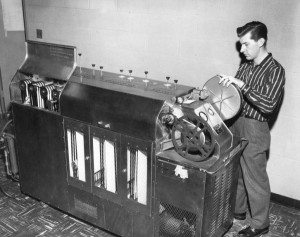 Forty years ago, as a newbie producer at the ABC affiliate in Washington, DC, I had to juggle live coverage of the Watergate hearings. The length of our midday newscast depended on when the network dumped out, and they usually gave us little warning. Some days we’d run an 18-minute newscast; other days we’d have to fill almost 40.
Forty years ago, as a newbie producer at the ABC affiliate in Washington, DC, I had to juggle live coverage of the Watergate hearings. The length of our midday newscast depended on when the network dumped out, and they usually gave us little warning. Some days we’d run an 18-minute newscast; other days we’d have to fill almost 40.
No big deal? Think again. We had no computers back then. The rundown was on paper and we back-timed by hand. Our local stories were shot on film and sometimes got lost in the “soup” of the processor that lived in a back room, stinking of chemicals. After editing, the film stories were strung together in order on one reel to be loaded into a projector (the film chain) in the control room.
If a producer dropped a story, the film chain operator had to roll ahead to cue up the next one, which took an inordinate amount of time. We did have videotape–a huge two-inch machine, as I recall–that recorded the network news feed. (ABC cleverly called theirs the DEF, short for daily electronic feed.) Those stories were available as back-up in case a local story died, or as happened during the Watergate hearings, if the network left you high and dry with 10 extra minutes to fill.
The last hearing was held on this date in 1973. One year and a day later, Richard Nixon resigned the presidency.
Fun to see my former CBS News colleague Eric Engberg in the video. As if that wasn’t enough of a flashback for one day, August 7 was also the date in 1981 that the Washington Star printed its final edition. A newspaper I had once subscribed to and that had served the nation’s capital for 128 years declared bankruptcy and ceased publication. We didn’t know it then, but it was a sign of what was to come.
Thanks to Poynter’s “Today in history” feature for the reminders.









2 Comments
Jeez, what a crybaby!! It wasn’t all that bad. In fact, if you learned your trade, it could be great fun at times. TV News in the 70’s was an amazing period of discovery, experimentation, and almost every newsroom was still focused on journalism and getting an accurate, informative story on the air before the other guys. We were just starting to use mini-cams and microwave (no small feat), new graphics, and videotape was evolving. The fight for more time was to get more facts and info on the the air, NOT for the incessant promotion of thumbsucker features, celebrity news, social (or as we call it–anti social) media. We did not fill our newscasts with 5 minutes of traffic reports (which drivers cannot see anyway),nor were we constantly running inane tweets and other comments from viewers—“tell us what you think about that 5 alarm fire??” (Now it’s..Okay, move the traffic bunny up to the end of the first segment and after the break, we can run some Tweets..) And it’s all done with newsroom software. Back then, shows were timed with two column rundowns and a stopwatch. Film was tougher to use than tape and now servers, but what a rush when you re-slotted the first 10 minutes of your broadcast 4 minutes before air and pulled it off. Nowadays, getting a newscast on the air is like making popcorn in a microwave. Yet they still manage to screw it up.
Didn’t mean to come across as whiny. Those days were fun, indeed.